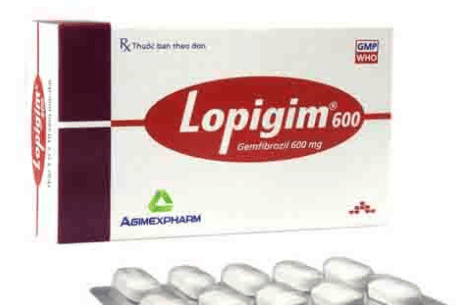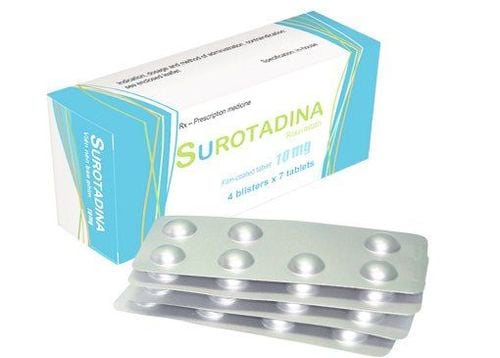This is an automatically translated article.
Drug Lopid, also known as Gemfibrozil, is a drug used to treat dyslipidemia. The drug is also used to prevent cardiovascular diseases in people with other underlying diseases that are at risk of complications for the patient.
1. What is Lopid? The effect of the drug Lopid
Lopid drug has the main ingredient Gemfibrozil and other excipients with a sufficient amount of 1 tablet. Lopid is indicated for the primary prevention of coronary heart disease (CHD) and myocardial infarction (MI) in patients with hypercholesterolemia, mixed dyslipidemia and hypertriglyceridemia; Treatment of different types of dyslipidemia such as dyslipidemia group III and V according to Fredrickson classification, dyslipidemia in people with diabetes mellitus, dyslipidemia in patients with jaundice.
The drug has two strengths:
Lopid 300mg; Lopid 600mg. Effects: Active ingredient Gemfibrozil is a Phenoxypentanoic Acid, which has the following effects:
Inhibits fat breakdown in the periphery; Reducing the amount of free fatty acids in the liver; Reduces the synthesis of VLDL, LDL (bad cholesterol) while increasing the synthesis of HDL (good cholesterol). Since then, Lopid has been shown to reduce mortality in people with a history of coronary artery disease, and reduce complications of dyslipidemia.
2. Indications of the drug Lopid
Indications of Lopid drug:
Lopid drug is indicated for use in the following cases:
Primary prevention of coronary heart disease (CHD) and myocardial infarction (MI) in people with hypercholesterolemia, disorders mixed dyslipidemia and hypertriglyceridemia group IIa, IIb and IV according to Fredrickson's classification. Treatment of other types of dyslipidemia: Dyslipidemia group III and V according to Fredrickson classification; dyslipidemia in people with diabetes mellitus; dyslipidemia in patients with jaundice. Treatment of elderly patients with elevated plasma triglyceride levels (group IV and V hyperlipidemia), at risk for pancreatitis and inadequate response to defined dietary regimens for disease control.
3. Instructions for using the drug Lopid
Before having a definitive diagnosis of dyslipidemia, the treating doctor will order to measure blood lipids many times. When you have followed a nutritious diet, healthy lifestyle as well as controlled underlying diseases (diabetes, hypothyroidism) but the lipid index is still abnormal, doctors will prescribe treatment with medicine.
During the use of Lopid medicine, you still have to maintain a healthy diet and lifestyle to control blood lipids. Treatment doctors usually monitor the effectiveness of treatment after 3 months to have the next treatment direction for a reasonable.
How to take Lopid:
Lopid is taken orally.
Dosage of Lopid is as follows:
The recommended daily dose is 900mg to 1200mg. The maximum daily dose is 1500 mg. The therapeutic dose is 900 mg taken once, taken half an hour before dinner. The therapeutic dose of 1200 mg is divided into 2 doses, taken 30 minutes before breakfast and dinner. Note: The therapeutic dose as shown above is for reference only. The specific treatment dose depends on the specific condition of each person and the progression of the disease. To get the right dose of treatment, you need to consult your treating doctor or medical professional.
In case of overdose: Overdosage has been reported with Lopid. Symptoms of drug overdose reported with overdose were abdominal cramps, abnormal liver function tests, diarrhea, increased creatine phosphokinase (CPK), joint and muscle pain, nausea and vomiting. . The treating doctor will appoint to carry out supportive measures to relieve symptoms in case of overdose. In case of missed dose: If you miss a dose, use it as soon as possible. However, if it is almost time for your next dose, skip the missed dose and take your next dose at the scheduled time. Note that you should never take twice the prescribed dose.
4. Undesirable effects of the drug Lopid
When using Lopid 300mg, you may experience unwanted effects (ADRs).
Hepatobiliary disorders: Jaundice due to biliary obstruction. Digestive system disorders: Pancreatitis. Central nervous system disorders: Appearance of dizziness, somnolence, paresthesia, peripheral neuritis, headache. Psychiatric disorders: Decreased sexual arousal or depression. Eye disorders: Blurred vision. Reproductive system disorders in men: Impotence. Musculoskeletal and connective tissue disorders: Arthralgia, synovitis, myalgia, myopathy, myasthenia gravis, pain in extremities, rhabdomyolysis. Skin and subcutaneous tissue disorders: Exfoliative dermatitis, erythematous skin rash, dermatitis, pruritus, angioedema, urticaria. Respiratory system, thoracic and mediastinal disorders: Laryngeal edema. Blood and lymphatic system disorders: Severe anemia, leukopenia, thrombocytopenia, eosinophilia, bone marrow hypoplasia. When experiencing unwanted effects of the drug Lopid, it is necessary to stop using and notify the treating doctor or go to the nearest medical facility for timely treatment.
5. Interactions of Lopid
Anticoagulants: You need to be careful when using Warfarin with Lopid. The therapeutic dose of Warfarin should be reduced to maintain the prothrombin time at the desired level to prevent bleeding complications. Routine coagulation time determination is necessary until stable coagulation time is clearly established. HMG-CoA-reductase inhibitors: Concomitant use of Lopid with simvastatin is contraindicated. Cases of severe myositis and myoglobinuria (rhabdomyolysis) have been reported with the concomitant use of Lopid with HMG-CoA-reductase inhibitors. CYP2C8 substrates: Lopid is an inhibitor of CYP2C8 and may increase exposure to drugs that are metabolised primarily by CYP2C8. Therefore, it may be necessary to reduce the therapeutic dose of drugs metabolised primarily by the CYP2C8 enzyme when co-administered with Lopid. Bile Acid Binding Resin: The bioavailability of Lopid may be reduced when co-administered with drugs that cause bile acid agglutination such as colestipol. These drugs should be taken at least 2 hours apart. Colchicine: Concomitant administration of colchicine and Lopid may increase the risk of neuromuscular toxicity and rhabdomyolysis. This risk may be increased in the elderly and in people with liver or kidney dysfunction. These symptoms usually persist from 1 week to several months after stopping treatment with colchicine.
6. Some notes when using Lopid
Contraindications Lopid (gemfibrozil)
Patients with hypersensitivity or hypersensitivity to any of the ingredients of the drug. Do not use the drug in people with severe liver and kidney failure There are no adequate studies on the safety of the drug in pregnant and lactating women. It is necessary to weigh the benefits and risks when using Lopid for this particular group of people.
Concomitant use of Lopid with any of the following drugs is contraindicated:
Simvastatin. Repaglinide. Dasabuvir. Note when taking Lopid drug:
Active ingredient Gemfibrozil increases cholesterol excretion into bile and increases the risk of gallstone formation. Lopid should not be used concurrently with statins, anticoagulants. Monitor liver function tests while using Lopid, if they persist, gemfibrozil therapy should be discontinued). Note to other populations:
Ability to drive and use machines: Studies on the effects of Lopid on the ability to drive and use machines have not been established. You may experience headaches, drowsiness, blurred vision, dizziness and visual disturbances after taking this medicine and affect your ability to drive or perform tasks that require concentration. Pregnancy: There are no adequate and well-controlled studies in pregnant women. The doctor will prescribe the use of Lopid during pregnancy after weighing the benefits of treatment outweigh the risks to the user or to the fetus. Lactation: Safety in nursing mothers has not been studied and established. It is not known whether Lopid is excreted in human milk. However, because many drugs are likely to be excreted in human milk, you should stop breastfeeding before starting treatment with Lopid. Lopid, also known as Gemfibrozil, is a medication used to treat dyslipidemia. The drug is also used to prevent cardiovascular diseases in people with other underlying conditions that are at risk of complications for the patient. To ensure effective treatment and avoid unwanted side effects, patients need to strictly follow the instructions of the doctor, professional pharmacist.
Follow Vinmec International General Hospital website to get more health, nutrition and beauty information to protect the health of yourself and your loved ones in your family.
Please dial HOTLINE for more information or register for an appointment HERE. Download MyVinmec app to make appointments faster and to manage your bookings easily.













